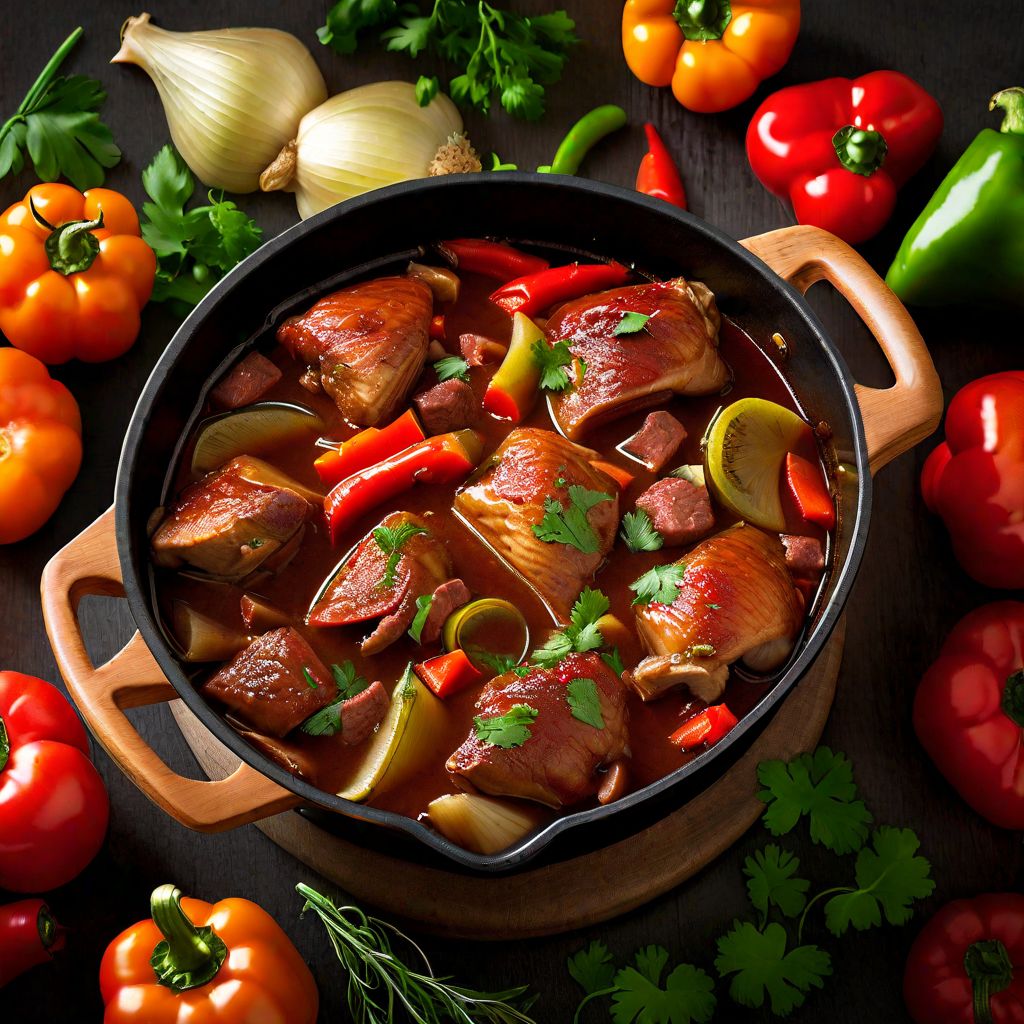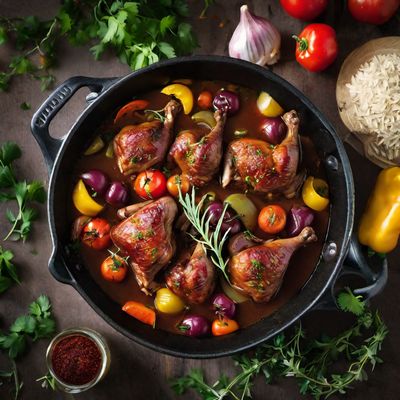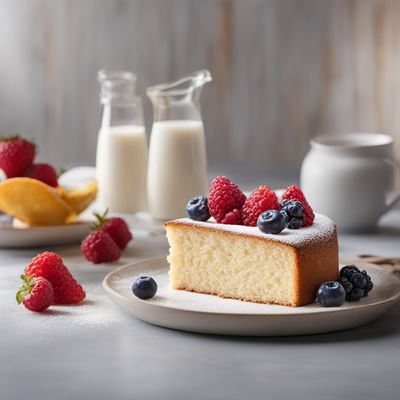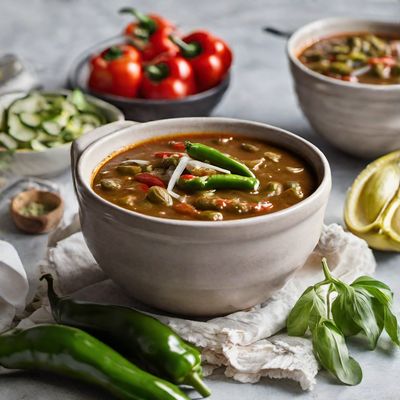
Recipe
Coq au Vin - Puerto Rican Style
Pollo en Vino - A Puerto Rican Twist on a French Classic
4.8 out of 5
In Puerto Rican cuisine, we love to infuse our dishes with bold flavors and vibrant spices. This adaptation of the classic French dish, Coq au Vin, embraces the essence of Puerto Rican cooking while still paying homage to its French roots. Get ready to savor tender chicken simmered in a rich wine sauce, infused with the warmth and zest of Puerto Rican seasonings.
Metadata
Preparation time
20 minutes
Cooking time
1 hour
Total time
1 hour 20 minutes
Yields
4 servings
Preparation difficulty
Medium
Suitable for
Gluten-free, Dairy-free, Low-carb, High-protein, Paleo-friendly
Allergens
N/A
Not suitable for
Vegan, Vegetarian, Nut-free, Egg-free, Soy-free
Ingredients
While the original Coq au Vin is traditionally made with red wine, this Puerto Rican version incorporates the use of white wine, which adds a lighter and slightly sweeter flavor profile. Additionally, we will be incorporating Puerto Rican seasonings such as adobo and sofrito to infuse the dish with the vibrant flavors of the island. We alse have the original recipe for Coq au vin, so you can check it out.
-
1 whole chicken, cut into pieces (about 3-4 pounds) (1.4-1.8 kg) 1 whole chicken, cut into pieces (about 3-4 pounds) (1.4-1.8 kg)
-
1 cup (240 ml) white wine 1 cup (240 ml) white wine
-
1 cup (240 ml) chicken broth 1 cup (240 ml) chicken broth
-
4 slices of bacon, diced 4 slices of bacon, diced
-
1 onion, finely chopped 1 onion, finely chopped
-
4 cloves of garlic, minced 4 cloves of garlic, minced
-
1 red bell pepper, sliced 1 red bell pepper, sliced
-
1 green bell pepper, sliced 1 green bell pepper, sliced
-
1 tablespoon (15 ml) adobo seasoning 1 tablespoon (15 ml) adobo seasoning
-
2 tablespoons (30 ml) sofrito 2 tablespoons (30 ml) sofrito
-
1 tablespoon (15 ml) tomato paste 1 tablespoon (15 ml) tomato paste
-
1 bay leaf 1 bay leaf
-
1 teaspoon (5 ml) dried thyme 1 teaspoon (5 ml) dried thyme
-
Salt and pepper to taste Salt and pepper to taste
-
Fresh parsley, chopped (for garnish) Fresh parsley, chopped (for garnish)
Nutrition
- Calories: 450 kcal / 1880 KJ
- Fat: 25g (7g saturated)
- Carbohydrates: 8g (3g sugars)
- Protein: 45g
- Fiber: 2g
- Salt: 1.5g
Preparation
-
1.In a large skillet or Dutch oven, cook the diced bacon over medium heat until crispy. Remove the bacon from the pan and set aside, leaving the bacon fat in the pan.
-
2.Season the chicken pieces with adobo seasoning, salt, and pepper. Add the chicken to the pan with the bacon fat and brown on all sides. Remove the chicken from the pan and set aside.
-
3.In the same pan, add the chopped onion, minced garlic, and sliced bell peppers. Sauté until the vegetables are softened and fragrant.
-
4.Stir in the sofrito and tomato paste, cooking for an additional 2 minutes.
-
5.Return the chicken and bacon to the pan. Pour in the white wine and chicken broth. Add the bay leaf and dried thyme. Bring the mixture to a simmer.
-
6.Cover the pan and let the chicken simmer for about 45 minutes to 1 hour, or until the chicken is cooked through and tender.
-
7.Remove the bay leaf and garnish with fresh parsley before serving.
Treat your ingredients with care...
- Chicken — Make sure to thoroughly clean and pat dry the chicken before seasoning and browning it. This will help achieve a crispy and flavorful exterior.
- Sofrito — If you don't have access to store-bought sofrito, you can make your own by blending together onions, garlic, bell peppers, cilantro, and culantro. It adds a unique and aromatic flavor to the dish.
- Adobo seasoning — Adjust the amount of adobo seasoning according to your taste preferences. It adds a savory and slightly spicy kick to the dish.
- White wine — Choose a dry white wine with a good acidity, such as Sauvignon Blanc or Pinot Grigio, to enhance the flavors of the dish.
- Bacon — Use thick-cut bacon for a smoky and rich flavor. If you prefer a leaner option, you can use turkey bacon instead.
Tips & Tricks
- For an extra depth of flavor, marinate the chicken in the white wine and adobo seasoning for a few hours or overnight before cooking.
- Serve the Pollo en Vino with a side of white rice or mashed yuca to soak up the delicious sauce.
- If you prefer a thicker sauce, you can mix a tablespoon of cornstarch with a little water and add it to the simmering sauce, stirring until thickened.
- Leftovers can be stored in the refrigerator for up to 3 days and taste even better the next day as the flavors meld together.
- Don't forget to remove the bay leaf before serving to avoid any unpleasant surprises.
Serving advice
Serve the Pollo en Vino hot, garnished with fresh parsley. It pairs well with a side of white rice or mashed yuca. Add a simple green salad or steamed vegetables for a complete and satisfying meal.
Presentation advice
To elevate the presentation of Pollo en Vino, arrange the chicken pieces on a platter and spoon the sauce over the top. Sprinkle with fresh parsley for a pop of color. Serve with a side of white rice or mashed yuca in a separate bowl.
More recipes...
For Coq au vin » Browse all
For French cuisine » Browse all
More French cuisine dishes » Browse all

Pithiviers
Pithiviers is a traditional French pastry that is typically made with puff pastry and a sweet or savory filling. It is named after the town of...

Croquembouche
Croquembouche is a French dessert that is made from cream puffs that are stacked into a cone shape and then drizzled with caramel.

Gaston Gérard Chicken
Gaston Gérard Chicken is a classic French dish that is loved for its rich and creamy flavors. It is a decadent and indulgent meal that is perfect...
More Puerto Rican cuisine dishes » Browse all

Sorullos
Puerto Rican Corn Fritters
Sorullos are a traditional Puerto Rican dish made with cornmeal and cheese. They are a popular street food and can be served as a snack or as a side dish.

Roast Pork Sandwich
Roast pork sandwich
The Roast Pork Sandwich is a classic sandwich that is made with slow-roasted pork and served on a roll. It is a hearty and flavorful meal that is...

Arroz y habichuelas
Rice and Beans
Arroz y habichuelas is a traditional dish from Puerto Rico that is made with rice and beans. It is a staple dish in Puerto Rican cuisine and is...










